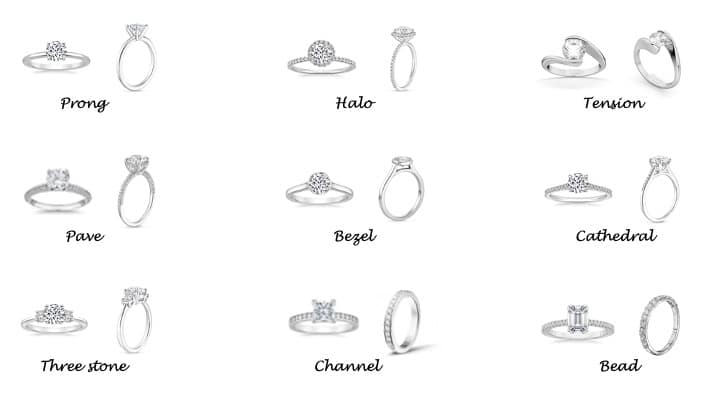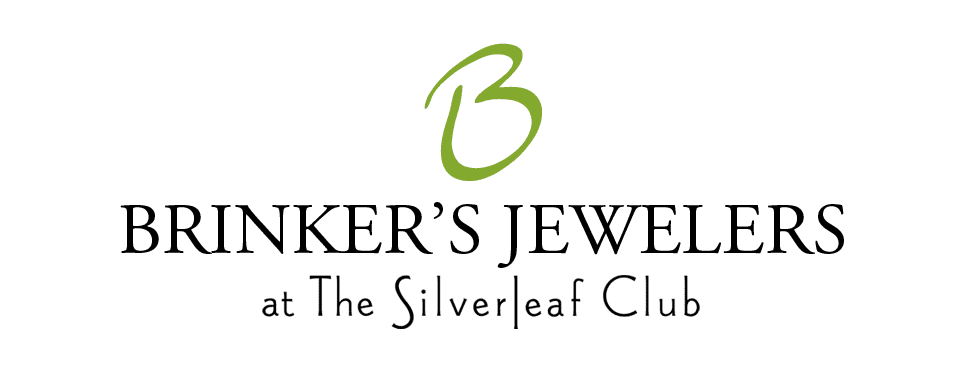Buying an engagement ring can feel like one of the most important purchases in a relationship. As modern perceptions of marriage change, the approach to engagement ring shopping changes too. 63% of couples now choose engagement rings together, and more couples have at least some discussion beforehand about preferences and sizing. These conversations make finding the “right” engagement ring a lot less risky.
However, you might be asking, “What makes a good engagement ring?” First and foremost, the perfect engagement ring for each person is as unique as its wearer. Perhaps the better question to ask is, “How do you get the engagement ring you want?”
In this guide to buying an engagement ring, you will get the background on every aspect you need to know in the simplest terms. That way, you can choose a ring both you and your partner will cherish for years to come without feeling overwhelmed with the details.
What Does an Engagement Ring Symbolize?
The Ancient Romans were the first recorded people to use engagement bands. Engagement bands were a mark of ownership, love, and obedience. Rings were given to future brides to show others that they were “taken” and “off the market” to other potential suitors.
Women in Rome wore rings of ivory, bone, copper, flint, and iron — although gold rings have been found dating back to the earlier Common Era (CE). Romans wore the ring on their left ring finger, as they believed a vein located there connected directly to the heart.
In the centuries afterward, a more extravagant engagement ring was meant to indicate the husband’s wealth and status. As a wife was unable to own property or make money for herself, the engagement ring signified how heavily a wife could rely on her husband for financial support.
Nowadays, the symbolism of engagement bands is centered more on love and commitment. As rings are circles, they have no beginning or end, so they represent the neverending love and devotion between two people.
You or your spouse should wear your engagement ring however feels most comfortable. In many Western cultures, the ring is still worn on the left-hand ring finger. However, some cultures believe the left hand is unlucky, so they wear the engagement band on their right-hand ring finger.
How is an Engagement Ring Different From a Wedding Ring?
The symbolism of an engagement ring representing endless love could be used to describe a wedding ring too. So how does a wedding ring differ from an engagement ring?
Quite simply, the difference between an engagement ring and a wedding ring is the stage of marriage during which they’re worn. The engagement ring is traditionally presented at a marriage proposal, or when a couple decides to get married. It’s worn both in the lead-up to the marriage and often after the wedding.
Wedding rings are exchanged during the wedding ceremony and represent that the official bond of marriage has been made. They’re traditionally worn for the rest of the marriage.
It’s common for an engagement ring to be more ornate and fancy than the wedding ring. The wedding ring is often a classic band that doesn’t feature diamonds, gemstones, or ornamentation.
Sometimes, couples buy the engagement ring with the wedding band as a pair. This ensures they’re uniform and go perfectly together, but it’s not necessary to do this. The priority should be to buy each ring when you feel it’s the right time. Some couples choose matching wedding bands or complement the engagement ring with multiple stacking rings rather than one wedding ring.
Another option still is to forgo the engagement ring entirely or wear the engagement ring as the wedding ring too. In some couples, both partners wear an engagement ring. It all depends on how both of you would prefer to express your commitment to one another.
How Much Should I Spend on an Engagement Ring?
Setting an engagement ring budget can be tricky. The old engagement ring price rule announced that you should spend three months’ salary on your engagement ring — but old sayings like these simply don’t hold up these days.
Instead, determine your budget based on how much money you’re comfortable spending and any special preferences your partner has. Your engagement should be an exciting time when you look forward to marrying your partner. It’s not a time to be worrying about how you’re going to pay next month’s bills because you felt pressured into spending more than you could afford on a ring.
We wrote a guide with more helpful tips on how to set the right engagement ring budget for you. Once you have a clear budget in place, you can move on to exploring the different options you can buy within that budget.
What are the Four Cs?
As a diamond is the most common choice for engagement ring ornamentation, you may wish to enlighten yourself on the four Cs. The four Cs are the official diamond grading system, and they refer to cut, color, clarity, and carat. These metrics will help you understand how to get the diamond ring that’s best suited to your preferences and budget.
There’s no need to feel overwhelmed by diamond jargon, though. You can make the process of buying an engagement ring as simple or as complicated as you’d like by paying attention to the factors you care most about.
Here’s an overview of the four Cs:
Cut
Engagement ring cut styles don’t describe their shape. Instead, the cut grade describes how light reflects off of a stone’s proportions and angles. This grade, all the way from excellent to poor, affects how brightly the diamond sparkles.
When a diamond is cut into a shape, like a pear or round shape, a good cut is performed within specific parameters so the facets interact effectively with light to produce maximum shine. A well-cut diamond will reflect light from one facet to another, to project the light through the top of the stone as brightly as possible.
Color
Diamonds come in a spectrum of colors, and these shades are graded on a D-to-Z scale. A D-grade is a completely colorless diamond, whereas a Z-grade diamond has full color and is visibly yellow. Colorless diamonds are the rarest and most expensive. Recently, different colors have been introduced into the grading system, such as pink and chocolate. In these cases, the more saturated the color, the more valuable the diamond becomes.
Don’t expect to notice the difference between each color grade. They’re so subtle that stones have to be graded under controlled lighting conditions. Choosing a diamond in the range of G-I will appear just as colorless to the naked eye as a D-grade, but can save the buyer a lot of money.
Clarity
As they form within the earth over millions of years, diamonds naturally develop imperfections — tiny lines and flecks of black and white. A diamond’s clarity is the measurement of how big these “flaws” are and how many of them there are. Clarity is rated on a detailed scale. The scale determines metrics such as the number of imperfections, size of them, how visible they are, where they are, and how they affect the overall appearance of the diamond.
The closer a diamond is to flawless, the greater its clarity. A diamond with greater clarity is rarer, and this bumps the price up significantly. This being said, many imperfections are microscopic. A VS1 or VS2 clarity diamond usually offers the best value for money, as this grade will have more imperfections but will only feature flaws that cannot be seen with the naked eye.
Carat
The carat is the most accurate measurement of a diamond’s weight. It’s often abbreviated to “ct.”. Larger diamonds that weigh more are measured in a higher number of carats. A diamond with a higher carat number will have a higher value than a smaller diamond because it’s a rarer, larger stone. One metric carat is 200 mg, and it’s also the average size of a diamond in an engagement ring.
Despite how much discussion and prestige carat size receives, few diamond buyers consider it to be more important than the other factors in the four Cs. A well-cut diamond will sparkle brightly and make an engagement ring beautiful, no matter its size. A popular rule of thumb is to figure out your ideal grades for the other three metrics — cut, color, and clarity — before considering the carat. Once you’ve established the other three Cs, simply buy the largest carat that still fits within your budget.
What is Diamond Depth on an Engagement Ring?
The depth of the diamond on your engagement band refers to its proportions, symmetry, and polish. This quality of the diamond is a result of the work of the person who cut it. It’s also a crucial factor in the end appearance of the diamond in your engagement ring.
The diamond’s depth is the height measured in millimeters from the bottom tip to the flat, top surface of the diamond. When light enters the diamond, the depth controls how much of that light reflects back up into your eyes. The table of the diamond is its largest surface, or facet, and this also plays a big role in how the light that enters the diamond reflects out again and upward.
A diamond that is too shallow or too deep will cause light to pass through it at a low angle, escaping through the bottom of the diamond. The light should strike each facet in the inside of the diamond at an angle that reflects most of the light back up to the surface. That means it has the ideal depth.
The better the depth and table have been cut on a diamond, the more it will sparkle and shine in the daylight. Understanding the depth of a diamond is a demonstration of how important the cut of your diamond is. It also emphasizes why you may want to prioritize obtaining a well-cut diamond over other factors such as carat and color.
Why is the Shape of the Ring's Stone Important?
The shape of the center stone in your engagement ring will affect the look and uniqueness of the ring a great deal. Therefore, choosing the stone’s shape is an essential factor in deciding on the overall style of the ring. It will also determine how you can move forward with the other design considerations you need to make.
Some people wear an engagement ring with a classic round-shape stone, but there are numerous other shapes to consider. Here are some of the most popular shapes for engagement ring stones:
- Round — the most popular shape and an excellent way to showcase the sparkle of a diamond or gem
- Oval — a rounded, longer stone that compliments lean fingers
- Marquise — a rounded stone that pinches into two points at the top and bottom
- Pear — understandably, a pear-shaped stone has a rounded base that culminates to a point at the top
- Princess — with a flat top but an extended body beneath, this stone shape resembles an upside-down pyramid
- Cushion — a square shape with rounded edges, this old-fashioned style was created in the 1800s
- Emerald — not to be confused with the type of stone, an emerald shape is a rectangular box with four sides of reflection
- Asscher — like an emerald but square-shaped, asscher shapes are unique and carry an art deco style
The shape of the engagement ring stone can also affect how large it appears. If the size of the bling is an important factor for you, consider an emerald or marquise cut. You’ll get a larger-looking stone without having to spend out more on a bigger carat.
What is a Ring's Setting?
When people talk about the style of an engagement ring, they often talk about the setting. But the two terms, style and setting, mean different things. The setting describes the technique used to set, or mount, the diamond into the body of the ring. This differentiation is popular with buyers because a good setting should highlight the beauty of an engagement ring’s diamond. The stone should also be set securely into the metal and not be prone to chipping.
The setting of an engagement band can largely affect its actual value in a few ways. The popularity of the setting, the use of small diamonds, and the number of stones in a ring can all bring its market value higher or lower. However, the size and characteristics of the center stone in your engagement ring will still have a much larger effect on its price tag.
If you’re looking for engagement ring ideas and inspiration, here are some of the most popular setting styles to consider:

Prong Setting
This setting relies on slim, metal claws to hold the stone in place, usually four or six. Each claw should be carefully tapered and angled against the surface of the stone. More of the surface of the stone is visible and light can both enter and exit it.
Halo Setting
A center stone is surrounded by smaller diamonds, giving it a “halo” of diamonds that emphasizes the visual impact of the main stone. Rings can even have single or double halos of diamonds, which have two outer rows.
Bead Setting
Small, round pieces of metal are raised from the metal’s surface and used to secure the main stone into place. In a bead setting, smaller stones are often embedded into the band of the ring.
Pavé Setting
Smaller stones are often set around the half of the band closest to the center stone, and they share a bead. These create an impressive effect as if the whole surface is paved with continual diamonds.
Micro-Pavé Setting
In this setting, the same principles as pavé are applied; however, the paved, accenting stones are even smaller.
Bezel Setting
A metal rim rises from the band and encircles a stone, securing it into place and protecting its edges. Only the crown, or top, of the diamond is exposed. A partial bezel setting encapsulates part of the stone with metal.
Three-Stone Setting
A trio of stones is situated next to one another, usually held in place by three sets of prongs. The middle stone is normally larger and takes center stage, flanked by two smaller but equally impressive stones on either side. These smaller stones are usually of a different type, such as sapphire or emerald, to create an interesting and colorful style.
Tension Setting
In a tension setting, the stone is held into place by opposing directions of pressure alone. The sides of the stone will be exposed, allowing light to enter and exit it exceptionally well. This setting also gives the illusion that the stone is floating, suspended in space.
Cathedral Setting
Metal arches extend from the band in a cathedral setting, lift the stone upward, away from the body, and set it high. Prongs or a bezel often accompany the arches to hold the stone into place. This elegant setting is traditional and resembles a grand and elaborate building — like a cathedral.
Channel Setting
A channel setting features smaller stones deeply set that run along the band, within two parallel walls of metal on either side. The ring still features a center stone. There are single-channel rings or double-channel rings, featuring two parallel rows of diamonds.
What Metals Are Used in Engagement Rings?
Your four general options for the metal in an engagement ring are platinum, white gold, yellow gold, or rose gold. The choice of metal has a huge effect on a ring’s style.
A good way to gauge the right metal when buying the ring for your partner is to take a look at their favorite pieces of jewelry. Do they tend to wear more white gold or yellow gold? Most people have one or two favorite metals, and the engagement ring you buy should align with their existing style. If your partner has metal allergies, platinum is naturally hypoallergenic.
A popular engagement ring metal for a long time has been platinum. White gold makes for a slightly less pricey option than platinum. As it rises in popularity, however, many engagement rings now are being made in rose gold. Additionally, different colored gemstones are especially popular when embedded into yellow gold metal.
Do Engagements Rings Have to Feature Diamonds?
Diamond engagement bands are popular, of course, but they’re not your only option. Today’s engagement ring buyers, millennials especially, are choosing diamonds in their rings less often.
This isn’t just a recent trend. It wasn’t until the diamond mines of Africa were discovered in the 1870s that diamonds became available to anyone, even if they weren’t a member of the cultural elite. Even then, “posey rings” containing different colored gems were a popular choice. The relatively recent popularization of diamonds for engagement rings is the result of a clever marketing campaign in the 1930s that told us “a diamond is forever.”
For unique engagement ring ideas, look no further than the wide range of colored gemstones and different materials you can have set into your band instead of diamonds:
- Moissanites — These gemstones from the stars very closely resemble diamonds but are more sparkly, with bright rainbow flashes.
- Morganites — A lot like diamonds, morganites produce a soft and remarkable sparkle with a rose gold hue.
- Sapphires — These stones are durable and traditional. They don’t only come in the traditional blue; you can find a sapphire in almost any color.
- Emeralds — They never fail to produce a vibrant and stunning shade of green — enough even to catch attention from across the room.
Where Can I Find the Perfect Engagement Ring?
Engagement ring shopping doesn’t have to be a stressful experience. In this guide, we’ve laid out the main things you should know before buying an engagement ring, so you can go forward with the confidence that you’ve got this task in hand.
Now you just need to find the engagement ring that’s as special and beloved as the person you want to spend the rest of your life with. Brinker’s Jewelers has an extensive selection of beautiful engagement and wedding rings. We can also offer further specialist support and advice on how to tailor your ring for your partner’s lifestyle, hobbies, and habits. Take a look at our online shop, or visit us in-store, today.
















